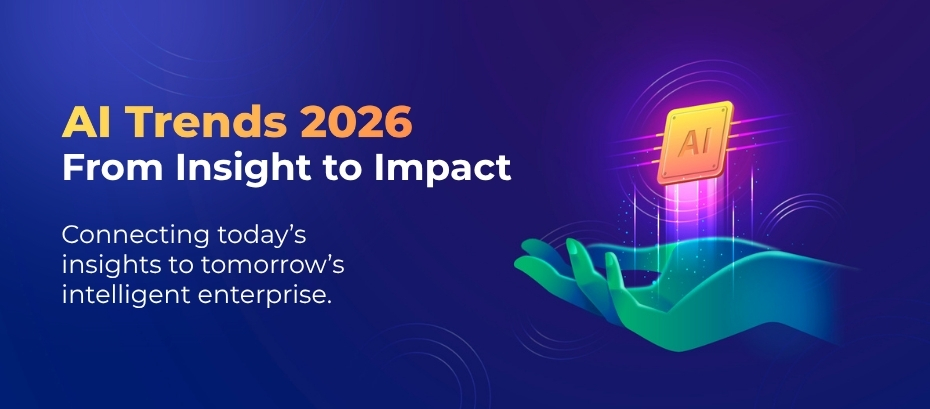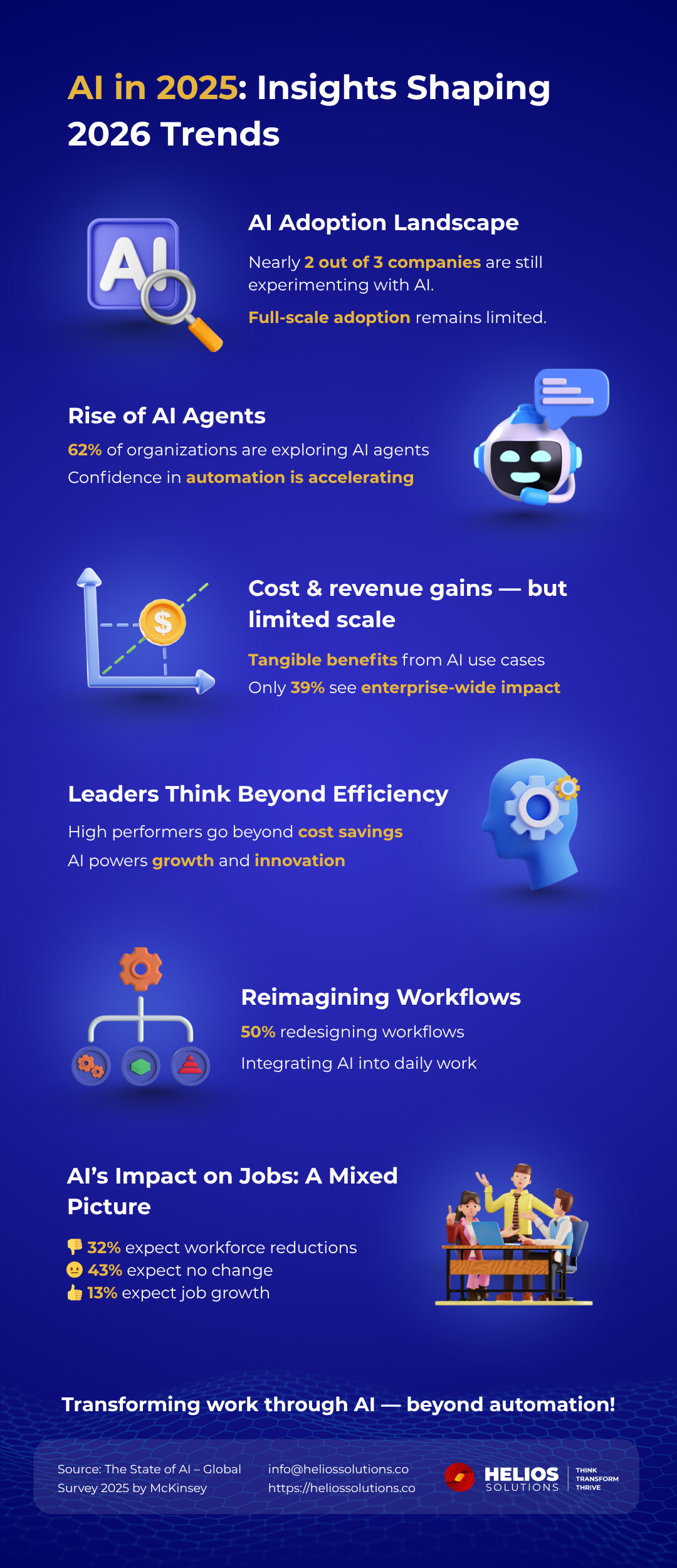Artificial Intelligence is no longer just a technological frontier—it’s becoming the foundation on which the modern enterprise is being rebuilt. Over the past few years, we’ve witnessed organizations move from curiosity to capability, from pilots to production. Yet, as we step into 2026, a clear shift is taking shape. The conversation around AI is no longer about adoption; it’s about transformation. Intelligent agents are beginning to take on complex tasks autonomously, generative AI is embedding itself into workflows, and data is no longer seen as static but as fuel for decision-making, creativity, and growth.

2025 was a defining year for insight. It revealed how companies experimenting with AI laid the groundwork for the breakthroughs we’re now beginning to see. The lessons learned, from scaling challenges to the rise of AI agents, are shaping how the next phase of enterprise intelligence unfolds. The focus is widening from individual use cases to systems that think, learn, and act across the business ecosystem.
To capture this evolution, we’ve visualized the key insights that are propelling AI into its next chapter.
Before we explore the defining trends of 2026, here’s a look at the forces from 2025 that set the stage for what’s ahead.
Visual Insight: Mapping the AI Shift
The infographic explores where enterprises are investing, how workflows are evolving, and what’s next on the horizon for generative and intelligent AI systems.

10 AI Trends in 2026 That Will Transform Enterprises and Workflows
The year 2026 is shaping up to be a defining one for artificial intelligence. As organizations transition from early experimentation to deep integration, AI is no longer a peripheral innovation—it’s becoming the core engine driving change across industries.
From agentic systems to generative platforms, the boundaries between human and machine capabilities are blurring, creating both opportunities and responsibilities. Let’s explore the key AI trends reshaping how we live, work, and innovate in 2026.
1. The Age of Intelligent Agents
AI agents are evolving from passive responders to proactive decision-makers that can anticipate needs and take initiative. In 2026, these intelligent systems will manage complex, multi-step tasks across business functions — automating workflows, communicating across platforms, and making context-aware decisions with minimal human input.
Organizations that embrace these agentic systems will gain faster execution and smarter operations, allowing employees to focus more on creativity, strategy, and oversight. The future of productivity will be defined by this partnership — where human judgment and AI initiative work together to drive efficiency and innovation.
2. AI-Native Platforms Redefine Development
Software development is entering its next phase — the era of AI-native engineering. Developers are moving beyond traditional, line-by-line coding toward AI-driven platforms that can generate, test, and optimize applications in real time. These intelligent systems act as creative collaborators, transforming prompts into production-ready code and streamlining every stage of the development lifecycle.
This new paradigm will drastically shorten development cycles and enable rapid deployment of enterprise-grade solutions. By automating routine coding and debugging, teams can redirect their focus toward innovation, design, and strategic problem-solving. This will result in faster builds, smarter systems, and a new generation of software shaped by human vision and AI precision.
3. Privacy-First AI: The Edge Advantage
With AI now deeply embedded in enterprise workflows, privacy and data security have become mission-critical. As organizations integrate generative and predictive models into daily operations, the question is no longer just what AI can do but how securely it can do it. In 2026, Edge AI is entering a new phase of maturity, with more enterprises running models on secure devices and within their own environments. This approach ensures sensitive data remains inside protected digital boundaries while still enabling advanced analytics and automation.
This evolution toward privacy-focused AI frameworks reflects a maturing ecosystem that values trust as much as innovation. From hospitals safeguarding patient records to financial institutions managing confidential data, enterprises are adopting AI architectures built for compliance, transparency, and ethical responsibility. In this new phase, privacy isn’t a trade-off for intelligence — it’s becoming the foundation of trustworthy AI.
4. Domain-Specific Models Take the Spotlight
The era of one-size-fits-all models is fading. As organizations demand more precise, context-aware intelligence, Domain-Specific Language Models (DSLMs) are taking center stage. Unlike general-purpose models, these systems are fine-tuned for specific industries, functions, or use cases, bringing domain fluency and operational accuracy to the forefront. Whether it’s understanding medical terminology, financial jargon, or manufacturing workflows, DSLMs excel where general AI often falls short.
In 2026, DSLMs will move from experimental tools to core components of enterprise AI ecosystems. Their ability to deliver sharper insights, more relevant recommendations, and context-rich reasoning will make them invaluable across functions—from supply chain forecasting and regulatory compliance to clinical diagnostics and personalized marketing. For enterprises, this shift means AI that doesn’t just respond intelligently but also thinks in the language of their business.
5. Synthetic Data Fuels Smarter Insights
Real-world data isn’t always accessible or sufficient. That’s where synthetic data takes center stage. In 2026, AI will increasingly be used to generate artificial datasets for simulation, analytics, and algorithm training. By creating data that mimics real-world conditions, organizations can model systems, test hypotheses, and improve prediction accuracy — all without compromising sensitive or proprietary information.
As privacy regulations tighten and access to quality data becomes more complex, synthetic data offers a safe, scalable alternative. It enables faster experimentation, supports rare-event modeling, and fuels innovation across data-sensitive sectors such as healthcare, finance, and manufacturing. In essence, it’s becoming the new raw material of AI development, driving responsible progress while protecting what matters most — real-world privacy.
6. AI-Powered Storytelling Takes the Stage
Generative AI is reshaping how stories are told and experienced. From dynamic visuals to adaptive scripts, AI-generated video is moving from novelty to norm. Production houses are using generative tools to reduce costs, shorten timelines, and enhance creativity, blending human direction with machine precision. What once took weeks of animation or effects work can now be done in hours — opening new possibilities for filmmakers, advertisers, and creators alike.
But the impact won’t stop at entertainment. In 2026, expect generative media to expand into education, marketing, and enterprise communication, where visual storytelling becomes faster, more personalized, and infinitely scalable. As AI learns to mirror human creativity, the lines between creator, collaborator, and consumer will continue to blur — ushering in an era where imagination is powered by intelligence.
7. Authenticity in the Age of Automation
As AI-generated content floods every platform, authenticity is emerging as the ultimate differentiator. With audiences now able to spot machine-made content instantly, brands and creators are rediscovering the value of the human touch — emotion, nuance, and genuine experience that algorithms can’t replicate. In 2026, the push for realness will redefine how organizations communicate, from marketing campaigns to internal storytelling.
The most successful communicators will blend human creativity with AI efficiency, using machines to accelerate production but not to replace perspective. In this new landscape, trust and relatability will become as important as speed and scale — and content that feels both intelligent and authentic will stand out in a sea of synthetic voices.
8. Secure and Trustworthy AI Systems
Security and provenance are becoming inseparable from innovation. As AI systems influence decisions in finance, governance, and everyday operations, ensuring data integrity and traceability is no longer optional; it’s essential. In 2026, organizations will increasingly adopt AI security platforms and digital provenance tools to verify where data originates, how it’s processed, and whether it has been altered along the way. This shift marks a growing recognition that trust in AI begins with transparency.
To sustain that trust, enterprises will lean on explainable and auditable AI pipelines, systems that not only deliver outcomes but also clarify how and why those outcomes were reached. By embedding security and provenance into the fabric of AI innovation, businesses can build confidence among regulators, stakeholders, and end-users—turning responsible AI into a true competitive advantage.
9. AI Accelerates Scientific Discovery
Generative AI is fast becoming an indispensable collaborator in scientific discovery. Across disciplines like drug design, materials science, and renewable energy, researchers are using AI to simulate experiments and test hypotheses at unprecedented speed. What once took months of computation or costly lab work can now be modeled in days, drastically accelerating the path from concept to breakthrough.
Beyond automation, AI is amplifying human curiosity and creativity. By generating possibilities, predicting outcomes, and identifying hidden patterns, generative models are helping scientists ask better questions—and find smarter answers. In 2026, the synergy between human insight and machine intelligence will redefine how we explore, innovate, and solve some of the world’s most complex challenges.
10. Evolving Roles and Skills in the AI Economy
As AI takes over routine and repetitive tasks, it’s not just reshaping workflows — it’s redefining what skills the workforce needs to thrive. The rise of AI is creating a surge in demand for entirely new roles that bridge technology, ethics, and human insight. Positions like AI ethicists, prompt engineers, model trainers, and human-AI coordinators will move to the forefront, ensuring that intelligent systems are not only efficient but also fair, transparent, and aligned with human values.
The next generation of digital talent won’t be limited to operating AI tools; they’ll design, guide, and evaluate them — setting standards for responsible and effective use. As AI becomes more embedded in every business function, the ability to collaborate intelligently with machines will define tomorrow’s most valuable professionals.
The Road Ahead: Transformation Over Adoption
As 2025 draws to a close, organizations are moving from experimenting with AI to transforming through it. The coming year will separate those who view AI as a tool from those who embrace it as a strategic partner in innovation, efficiency, and human augmentation. Businesses that build AI into their core processes—not as an add-on, but as an enabler—will be the ones setting the pace for the intelligent enterprise.
The future isn’t about humans versus machines; it’s about designing intelligent systems that amplify human creativity, judgment, and imagination. 2026 will be the year when experimentation gives way to transformation—and insight turns into intelligent impact.
Connect with our AI experts to explore how your enterprise can lead this shift.

